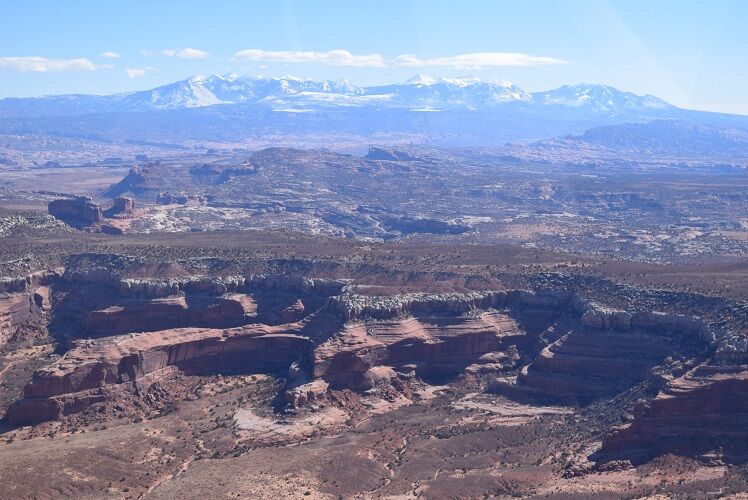Grand County commissioners considered several items related to Canyonlands Regional Airport at their Feb. 7 meeting, including a new contract for service with SkyWest Airline. SkyWest is the airport’s current Essential Air Service provider, using a federal subsidy to maintain a regular flight schedule. Airport Director Tammy Howland told the commission that SkyWest has done a good job, but she is disappointed that the airline’s bid proposes flights with fewer passengers than its previous contract.
“It was not the bid that we had hoped for,” Howland said.
Essential air service
The Essential Air Service program was created in the 1970s (when airlines were deregulated) to protect small communities from losing access to the national air transportation system. The United States Department of Transportation subsidizes flights to and from locations that otherwise might not be a profitable market for the airline.
“This is basically what’s allowing us to have commercial service at the airport,” Howland said.
Community eligibility is based on the need for air service and distance from a major airport. Canyonlands Regional Airport is one of 115 airports in the 48 contiguous states participating in the program. (There are 60 in Alaska.)
The USDOT has full authority to select carriers for Essential Air Service, thought the agency will take into consideration the preferences of the community. USDOT put out a request for proposals to serve the Moab area and received only one bid, from SkyWest. The proposal still includes service to both Denver and Salt Lake City, with six flights a week to each destination, and with those numbers being flexible to accommodate busier and slower seasons. However, the new contract would drop the number of passengers per flight from 50 to 30. Howland explained that this move allows SkyWest to employ pilots with an easier-to-obtain certification than the certification needed to fly 50 passengers. National media outlets have reported on regional airlines’ struggles to hire enough pilots to meet demand over the last few years.
“It’s a step backwards, but I think that this is essential for a regional carrier like SkyWest to build up their pilot pool and get back up to where the airline industry needs to be,” Howland said.
She added that she’s often asked why the airport can’t choose a different airline. It can, she said, but the cost of the subsidy to incentivize an airline to come to Moab would be about $5.5 million.
“We’re stuck with essential air service until we can grow to the point where an airline will see our market as self-sustaining,” Howland said.
Contracts with Essential Air Service providers are usually for two or four years; in the letter she drafted in support of selecting SkyWest, Howland requested that the contract be set for only two years, so that there would be a sooner opportunity to boost the number of passengers per flight back to 50.
“At the end of two years they can re-evaluate,” she said, and potentially raise the passenger threshold.
The new contract will further delay another threshold that had been looming. At a certain number of enplanements, requirements for law enforcement presence at the airport increase. The county had been preparing to budget for a sheriff’s deputy to staff the airport; however, with the number of passengers per flight reduced, it’s unlikely that position will be technically required any time in the next two years.
The commission voted unanimously to approve a letter in support of SkyWest’s bid.
Solar
The Airport Board has been discussing installing a solar array at Canyonlands Regional Airport for several years, and there may soon be an opportunity for funding the project.
Howland, along with Airport Board member Bill Hawley, presented to the commission a request to apply for a grant for $560,000 from the Federal Aviation Administration. If awarded, the county would be required to pay a 10% match.
The solar array would be used to power the airport, and the grant proposal also includes eight electric vehicle charging stations that would be installed at the airport. The 2023 budget for electricity at the airport is $26,000; thus, the facility would save money by generating its own solar power, and would make up the cost of the grant match in just a couple of years, Hawley pointed out.
“There’s not many things you can buy that pays for itself,” Commissioner Evan Clapper said in moving to approve the grant application.
Commissioner Bill Winfield noted that one limitation of solar arrays in the Moab area is that power transmission lines in the area are already at capacity; he praised the airport’s strategy of using the array to power its own facilities, avoiding the obstacle of maxed-out transmission lines.
The proposed array would reduce the airport’s carbon footprint by 116 tons per year, according to the grant application, and would have a lifespan of 25-30 years. The grant application also references Grand County’s participation in Utah’s 100 Communities program, which aims for 100% renewable energy sources for residents and businesses by 2030. The proposed solar array would be a step towards that goal.
Other projects
The commission also approved a rent study at the airport, which will examine market rates for rental of hangars, terminals, drop zones, parking lots, and other facilities. The study will cost $16,850, to be taken from the commission’s discretionary fund, and the information will be used to update the county’s fee schedule.
The body also approved an application for about $500,000 in funding from the FAA to replace an aging fence around the airport. If awarded, the county will again be responsible for a 10% match.




